Comprehensive Financial Report: Tesco PLC Analysis, Valuation, WACC
VerifiedAdded on 2023/01/12
|12
|2746
|2
Report
AI Summary
This report provides a financial analysis of Tesco PLC, comparing its performance against competitors using ratio analysis. It evaluates Tesco's company valuation using asset-based, dividend discount, and P/E ratio methods, critically assessing each methodology. The report also examines Tesco's capital structure, calculating the cost of debt, cost of equity, and weighted average cost of capital (WACC), while also addressing the challenges in WACC calculation. The analysis reveals insights into Tesco's profitability, liquidity, and financial risk, highlighting areas for improvement and strategic financial management. Desklib provides more solved assignments for students.

Paraphrase This Document
Need a fresh take? Get an instant paraphrase of this document with our AI Paraphraser
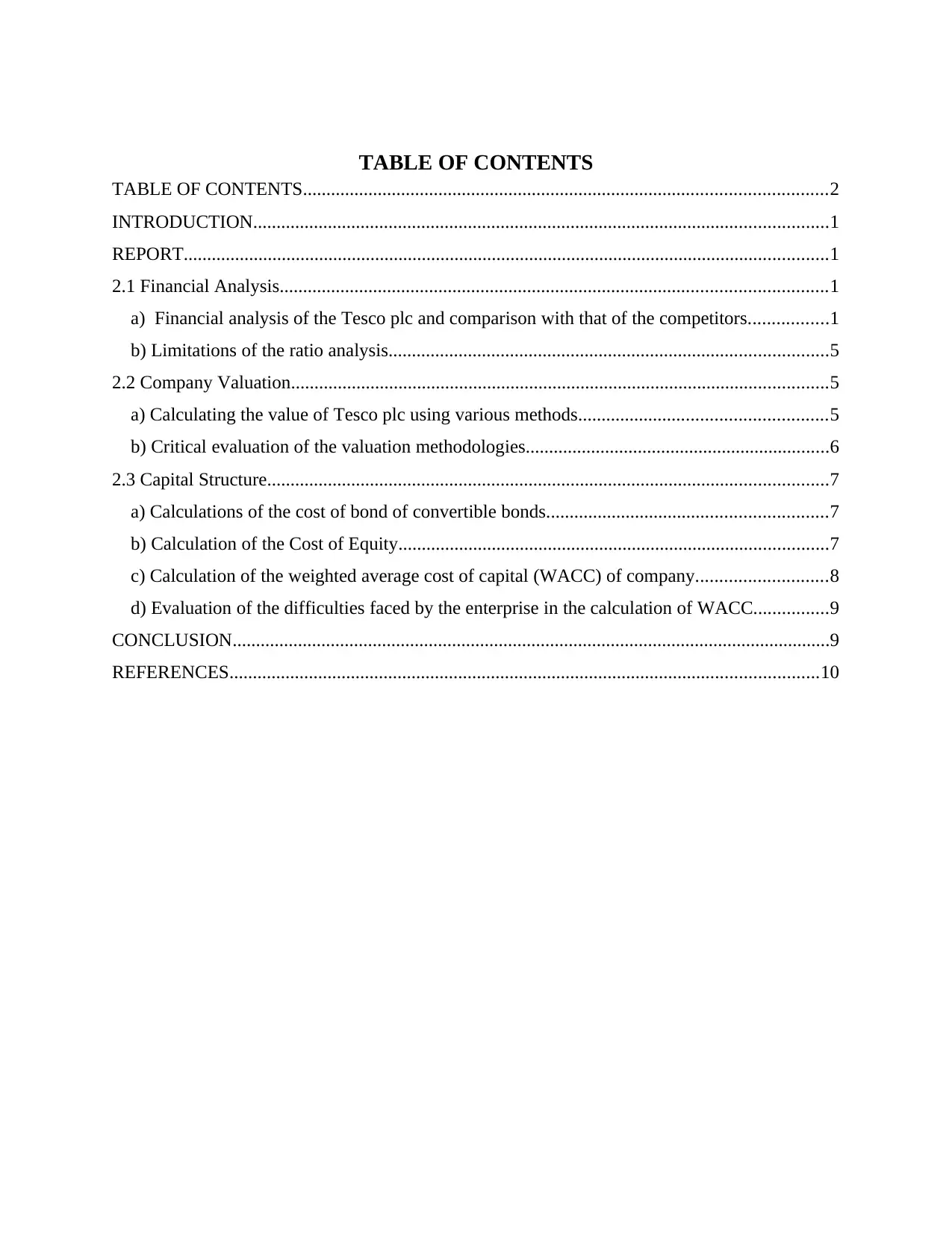
TABLE OF CONTENTS
TABLE OF CONTENTS................................................................................................................2
INTRODUCTION...........................................................................................................................1
REPORT..........................................................................................................................................1
2.1 Financial Analysis.....................................................................................................................1
a) Financial analysis of the Tesco plc and comparison with that of the competitors.................1
b) Limitations of the ratio analysis..............................................................................................5
2.2 Company Valuation...................................................................................................................5
a) Calculating the value of Tesco plc using various methods.....................................................5
b) Critical evaluation of the valuation methodologies.................................................................6
2.3 Capital Structure........................................................................................................................7
a) Calculations of the cost of bond of convertible bonds............................................................7
b) Calculation of the Cost of Equity............................................................................................7
c) Calculation of the weighted average cost of capital (WACC) of company............................8
d) Evaluation of the difficulties faced by the enterprise in the calculation of WACC................9
CONCLUSION................................................................................................................................9
REFERENCES..............................................................................................................................10
TABLE OF CONTENTS................................................................................................................2
INTRODUCTION...........................................................................................................................1
REPORT..........................................................................................................................................1
2.1 Financial Analysis.....................................................................................................................1
a) Financial analysis of the Tesco plc and comparison with that of the competitors.................1
b) Limitations of the ratio analysis..............................................................................................5
2.2 Company Valuation...................................................................................................................5
a) Calculating the value of Tesco plc using various methods.....................................................5
b) Critical evaluation of the valuation methodologies.................................................................6
2.3 Capital Structure........................................................................................................................7
a) Calculations of the cost of bond of convertible bonds............................................................7
b) Calculation of the Cost of Equity............................................................................................7
c) Calculation of the weighted average cost of capital (WACC) of company............................8
d) Evaluation of the difficulties faced by the enterprise in the calculation of WACC................9
CONCLUSION................................................................................................................................9
REFERENCES..............................................................................................................................10
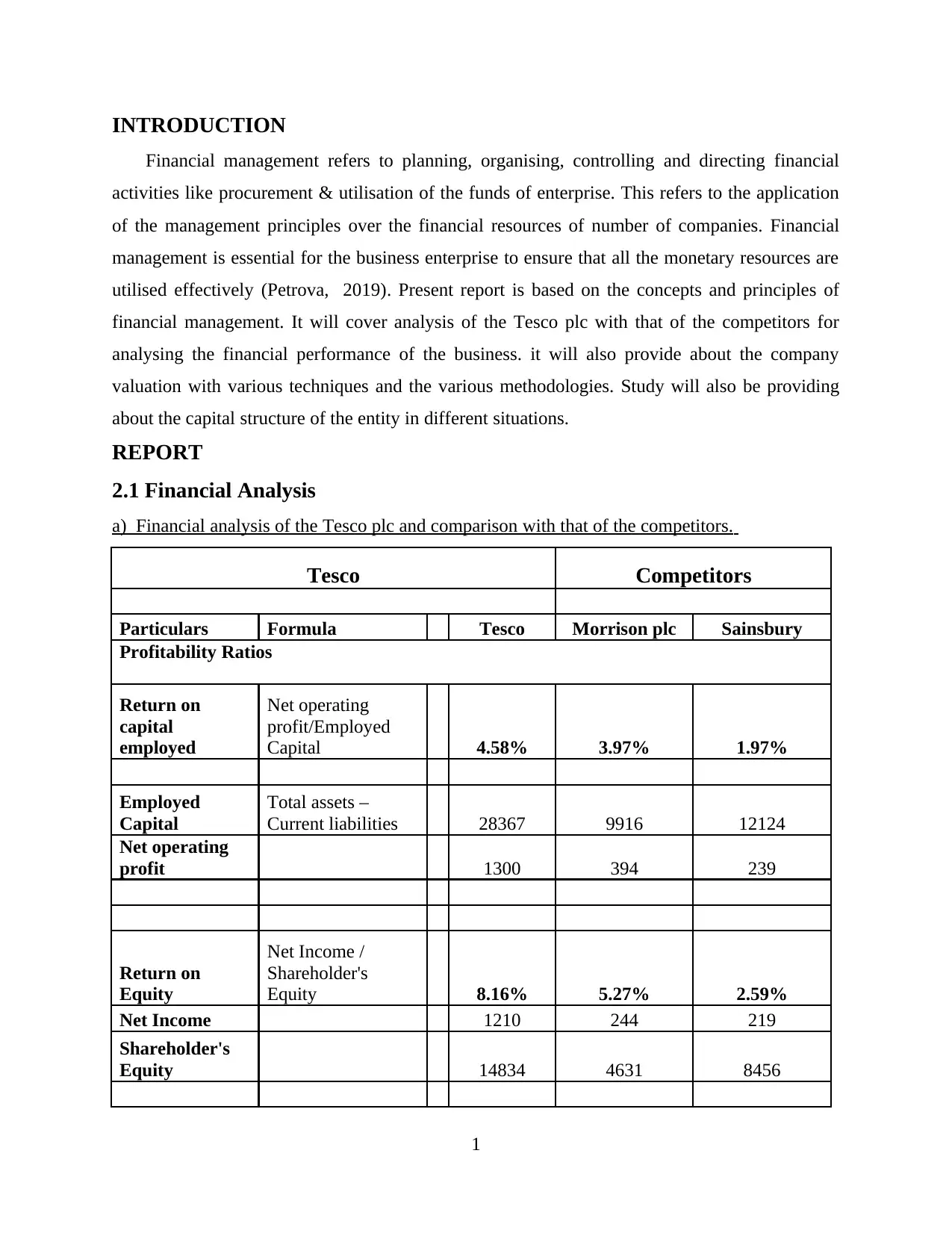
INTRODUCTION
Financial management refers to planning, organising, controlling and directing financial
activities like procurement & utilisation of the funds of enterprise. This refers to the application
of the management principles over the financial resources of number of companies. Financial
management is essential for the business enterprise to ensure that all the monetary resources are
utilised effectively (Petrova, 2019). Present report is based on the concepts and principles of
financial management. It will cover analysis of the Tesco plc with that of the competitors for
analysing the financial performance of the business. it will also provide about the company
valuation with various techniques and the various methodologies. Study will also be providing
about the capital structure of the entity in different situations.
REPORT
2.1 Financial Analysis
a) Financial analysis of the Tesco plc and comparison with that of the competitors.
Tesco Competitors
Particulars Formula Tesco Morrison plc Sainsbury
Profitability Ratios
Return on
capital
employed
Net operating
profit/Employed
Capital 4.58% 3.97% 1.97%
Employed
Capital
Total assets –
Current liabilities 28367 9916 12124
Net operating
profit 1300 394 239
Return on
Equity
Net Income /
Shareholder's
Equity 8.16% 5.27% 2.59%
Net Income 1210 244 219
Shareholder's
Equity 14834 4631 8456
1
Financial management refers to planning, organising, controlling and directing financial
activities like procurement & utilisation of the funds of enterprise. This refers to the application
of the management principles over the financial resources of number of companies. Financial
management is essential for the business enterprise to ensure that all the monetary resources are
utilised effectively (Petrova, 2019). Present report is based on the concepts and principles of
financial management. It will cover analysis of the Tesco plc with that of the competitors for
analysing the financial performance of the business. it will also provide about the company
valuation with various techniques and the various methodologies. Study will also be providing
about the capital structure of the entity in different situations.
REPORT
2.1 Financial Analysis
a) Financial analysis of the Tesco plc and comparison with that of the competitors.
Tesco Competitors
Particulars Formula Tesco Morrison plc Sainsbury
Profitability Ratios
Return on
capital
employed
Net operating
profit/Employed
Capital 4.58% 3.97% 1.97%
Employed
Capital
Total assets –
Current liabilities 28367 9916 12124
Net operating
profit 1300 394 239
Return on
Equity
Net Income /
Shareholder's
Equity 8.16% 5.27% 2.59%
Net Income 1210 244 219
Shareholder's
Equity 14834 4631 8456
1
⊘ This is a preview!⊘
Do you want full access?
Subscribe today to unlock all pages.

Trusted by 1+ million students worldwide
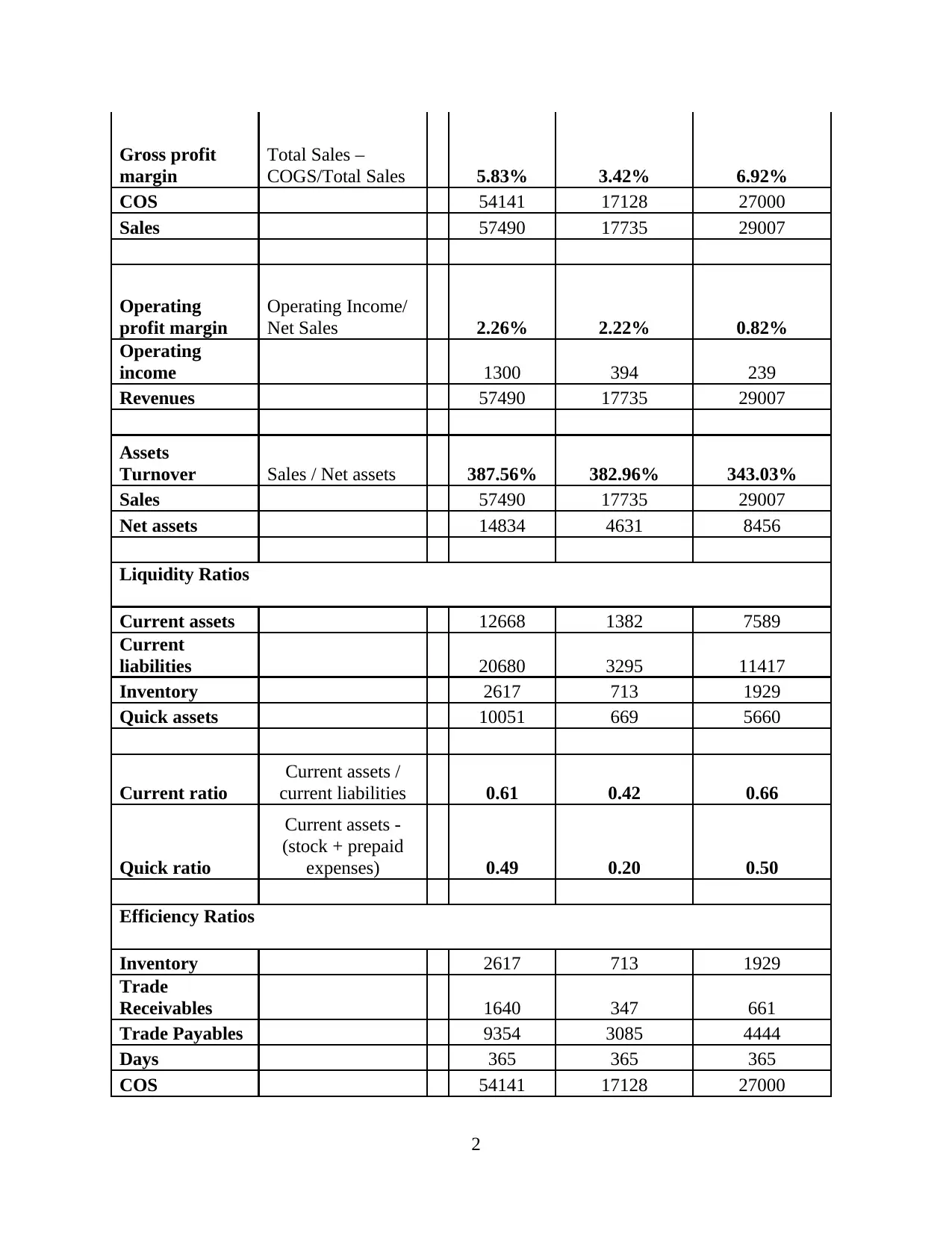
Gross profit
margin
Total Sales –
COGS/Total Sales 5.83% 3.42% 6.92%
COS 54141 17128 27000
Sales 57490 17735 29007
Operating
profit margin
Operating Income/
Net Sales 2.26% 2.22% 0.82%
Operating
income 1300 394 239
Revenues 57490 17735 29007
Assets
Turnover Sales / Net assets 387.56% 382.96% 343.03%
Sales 57490 17735 29007
Net assets 14834 4631 8456
Liquidity Ratios
Current assets 12668 1382 7589
Current
liabilities 20680 3295 11417
Inventory 2617 713 1929
Quick assets 10051 669 5660
Current ratio
Current assets /
current liabilities 0.61 0.42 0.66
Quick ratio
Current assets -
(stock + prepaid
expenses) 0.49 0.20 0.50
Efficiency Ratios
Inventory 2617 713 1929
Trade
Receivables 1640 347 661
Trade Payables 9354 3085 4444
Days 365 365 365
COS 54141 17128 27000
2
margin
Total Sales –
COGS/Total Sales 5.83% 3.42% 6.92%
COS 54141 17128 27000
Sales 57490 17735 29007
Operating
profit margin
Operating Income/
Net Sales 2.26% 2.22% 0.82%
Operating
income 1300 394 239
Revenues 57490 17735 29007
Assets
Turnover Sales / Net assets 387.56% 382.96% 343.03%
Sales 57490 17735 29007
Net assets 14834 4631 8456
Liquidity Ratios
Current assets 12668 1382 7589
Current
liabilities 20680 3295 11417
Inventory 2617 713 1929
Quick assets 10051 669 5660
Current ratio
Current assets /
current liabilities 0.61 0.42 0.66
Quick ratio
Current assets -
(stock + prepaid
expenses) 0.49 0.20 0.50
Efficiency Ratios
Inventory 2617 713 1929
Trade
Receivables 1640 347 661
Trade Payables 9354 3085 4444
Days 365 365 365
COS 54141 17128 27000
2
Paraphrase This Document
Need a fresh take? Get an instant paraphrase of this document with our AI Paraphraser
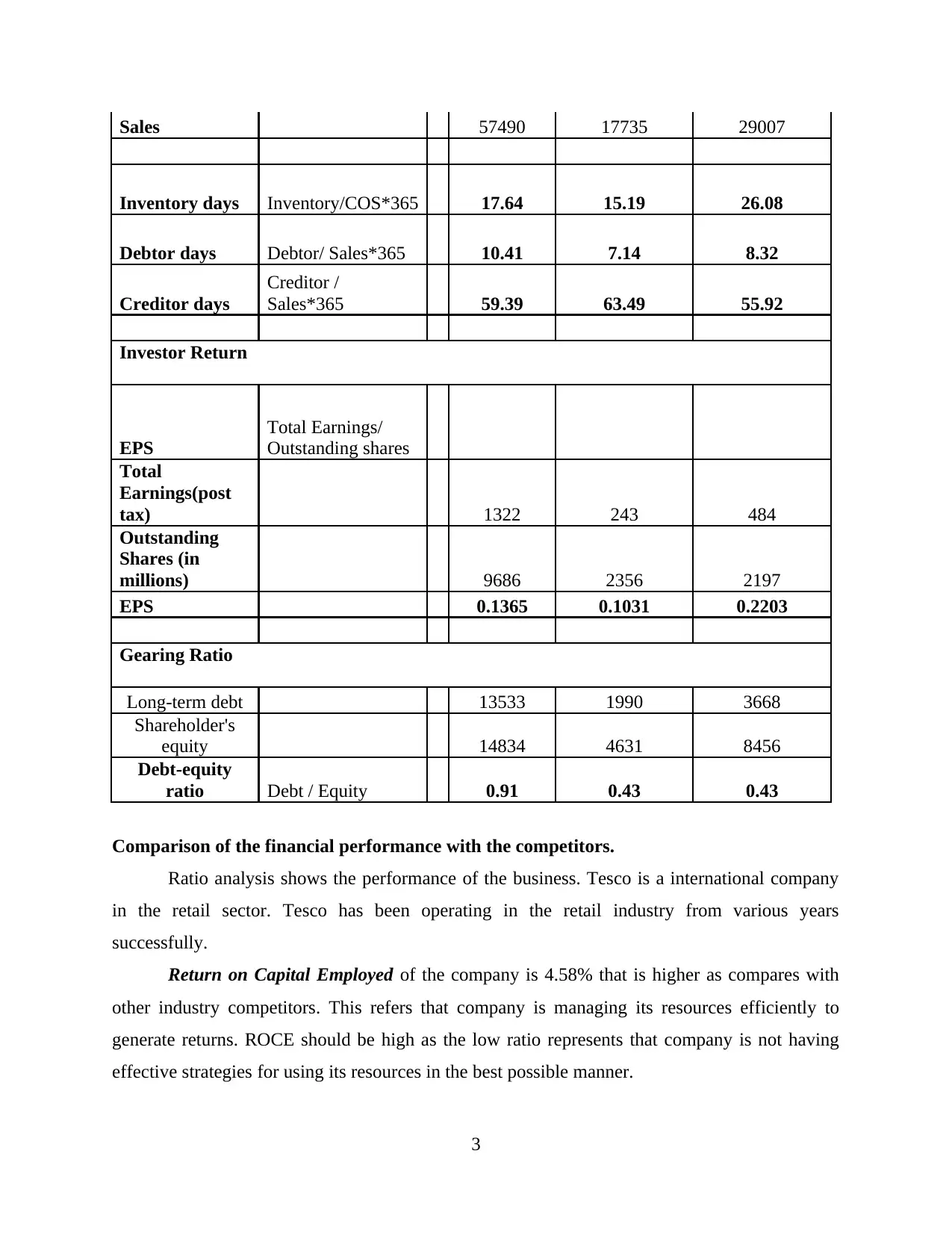
Sales 57490 17735 29007
Inventory days Inventory/COS*365 17.64 15.19 26.08
Debtor days Debtor/ Sales*365 10.41 7.14 8.32
Creditor days
Creditor /
Sales*365 59.39 63.49 55.92
Investor Return
EPS
Total Earnings/
Outstanding shares
Total
Earnings(post
tax) 1322 243 484
Outstanding
Shares (in
millions) 9686 2356 2197
EPS 0.1365 0.1031 0.2203
Gearing Ratio
Long-term debt 13533 1990 3668
Shareholder's
equity 14834 4631 8456
Debt-equity
ratio Debt / Equity 0.91 0.43 0.43
Comparison of the financial performance with the competitors.
Ratio analysis shows the performance of the business. Tesco is a international company
in the retail sector. Tesco has been operating in the retail industry from various years
successfully.
Return on Capital Employed of the company is 4.58% that is higher as compares with
other industry competitors. This refers that company is managing its resources efficiently to
generate returns. ROCE should be high as the low ratio represents that company is not having
effective strategies for using its resources in the best possible manner.
3
Inventory days Inventory/COS*365 17.64 15.19 26.08
Debtor days Debtor/ Sales*365 10.41 7.14 8.32
Creditor days
Creditor /
Sales*365 59.39 63.49 55.92
Investor Return
EPS
Total Earnings/
Outstanding shares
Total
Earnings(post
tax) 1322 243 484
Outstanding
Shares (in
millions) 9686 2356 2197
EPS 0.1365 0.1031 0.2203
Gearing Ratio
Long-term debt 13533 1990 3668
Shareholder's
equity 14834 4631 8456
Debt-equity
ratio Debt / Equity 0.91 0.43 0.43
Comparison of the financial performance with the competitors.
Ratio analysis shows the performance of the business. Tesco is a international company
in the retail sector. Tesco has been operating in the retail industry from various years
successfully.
Return on Capital Employed of the company is 4.58% that is higher as compares with
other industry competitors. This refers that company is managing its resources efficiently to
generate returns. ROCE should be high as the low ratio represents that company is not having
effective strategies for using its resources in the best possible manner.
3
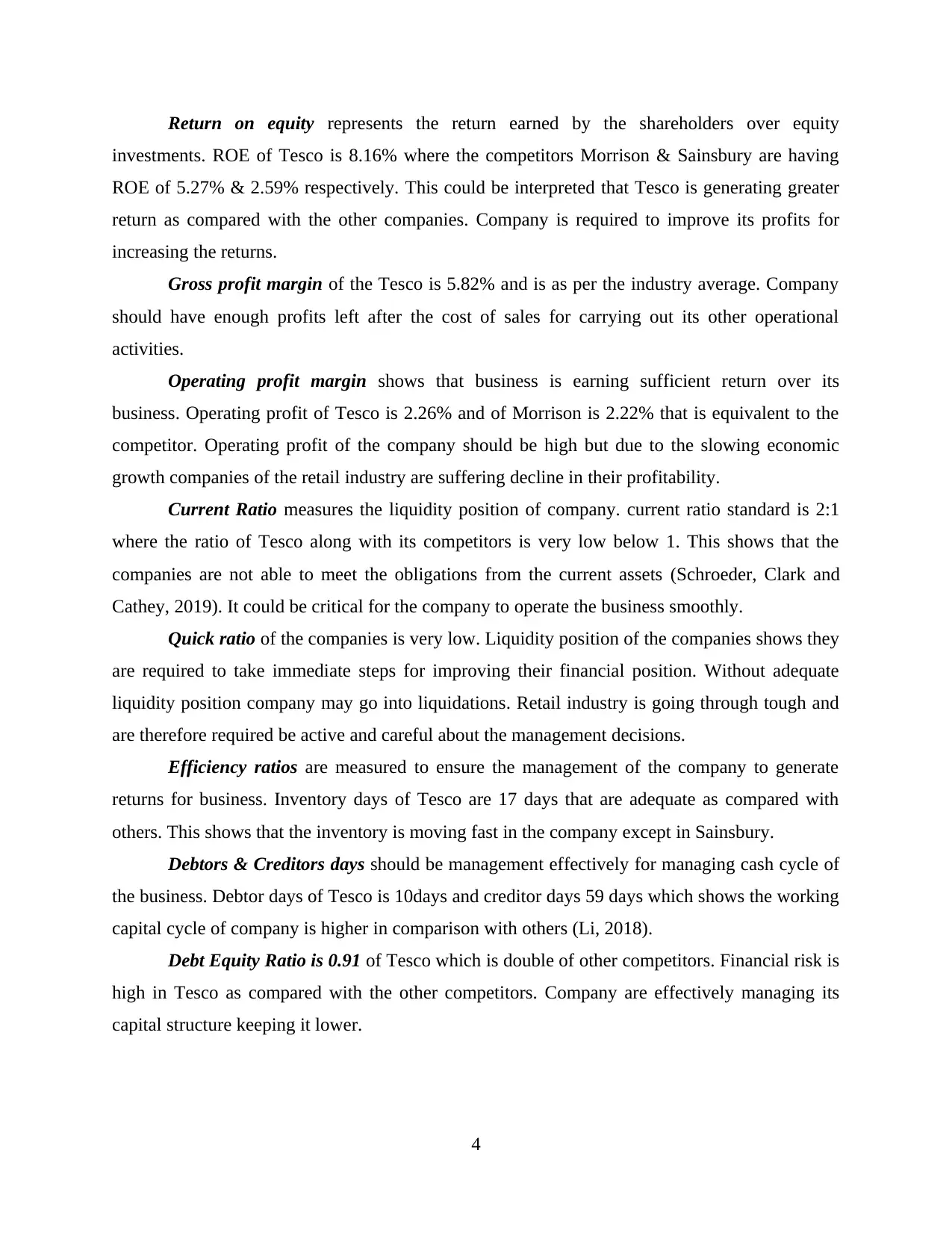
Return on equity represents the return earned by the shareholders over equity
investments. ROE of Tesco is 8.16% where the competitors Morrison & Sainsbury are having
ROE of 5.27% & 2.59% respectively. This could be interpreted that Tesco is generating greater
return as compared with the other companies. Company is required to improve its profits for
increasing the returns.
Gross profit margin of the Tesco is 5.82% and is as per the industry average. Company
should have enough profits left after the cost of sales for carrying out its other operational
activities.
Operating profit margin shows that business is earning sufficient return over its
business. Operating profit of Tesco is 2.26% and of Morrison is 2.22% that is equivalent to the
competitor. Operating profit of the company should be high but due to the slowing economic
growth companies of the retail industry are suffering decline in their profitability.
Current Ratio measures the liquidity position of company. current ratio standard is 2:1
where the ratio of Tesco along with its competitors is very low below 1. This shows that the
companies are not able to meet the obligations from the current assets (Schroeder, Clark and
Cathey, 2019). It could be critical for the company to operate the business smoothly.
Quick ratio of the companies is very low. Liquidity position of the companies shows they
are required to take immediate steps for improving their financial position. Without adequate
liquidity position company may go into liquidations. Retail industry is going through tough and
are therefore required be active and careful about the management decisions.
Efficiency ratios are measured to ensure the management of the company to generate
returns for business. Inventory days of Tesco are 17 days that are adequate as compared with
others. This shows that the inventory is moving fast in the company except in Sainsbury.
Debtors & Creditors days should be management effectively for managing cash cycle of
the business. Debtor days of Tesco is 10days and creditor days 59 days which shows the working
capital cycle of company is higher in comparison with others (Li, 2018).
Debt Equity Ratio is 0.91 of Tesco which is double of other competitors. Financial risk is
high in Tesco as compared with the other competitors. Company are effectively managing its
capital structure keeping it lower.
4
investments. ROE of Tesco is 8.16% where the competitors Morrison & Sainsbury are having
ROE of 5.27% & 2.59% respectively. This could be interpreted that Tesco is generating greater
return as compared with the other companies. Company is required to improve its profits for
increasing the returns.
Gross profit margin of the Tesco is 5.82% and is as per the industry average. Company
should have enough profits left after the cost of sales for carrying out its other operational
activities.
Operating profit margin shows that business is earning sufficient return over its
business. Operating profit of Tesco is 2.26% and of Morrison is 2.22% that is equivalent to the
competitor. Operating profit of the company should be high but due to the slowing economic
growth companies of the retail industry are suffering decline in their profitability.
Current Ratio measures the liquidity position of company. current ratio standard is 2:1
where the ratio of Tesco along with its competitors is very low below 1. This shows that the
companies are not able to meet the obligations from the current assets (Schroeder, Clark and
Cathey, 2019). It could be critical for the company to operate the business smoothly.
Quick ratio of the companies is very low. Liquidity position of the companies shows they
are required to take immediate steps for improving their financial position. Without adequate
liquidity position company may go into liquidations. Retail industry is going through tough and
are therefore required be active and careful about the management decisions.
Efficiency ratios are measured to ensure the management of the company to generate
returns for business. Inventory days of Tesco are 17 days that are adequate as compared with
others. This shows that the inventory is moving fast in the company except in Sainsbury.
Debtors & Creditors days should be management effectively for managing cash cycle of
the business. Debtor days of Tesco is 10days and creditor days 59 days which shows the working
capital cycle of company is higher in comparison with others (Li, 2018).
Debt Equity Ratio is 0.91 of Tesco which is double of other competitors. Financial risk is
high in Tesco as compared with the other competitors. Company are effectively managing its
capital structure keeping it lower.
4
⊘ This is a preview!⊘
Do you want full access?
Subscribe today to unlock all pages.

Trusted by 1+ million students worldwide
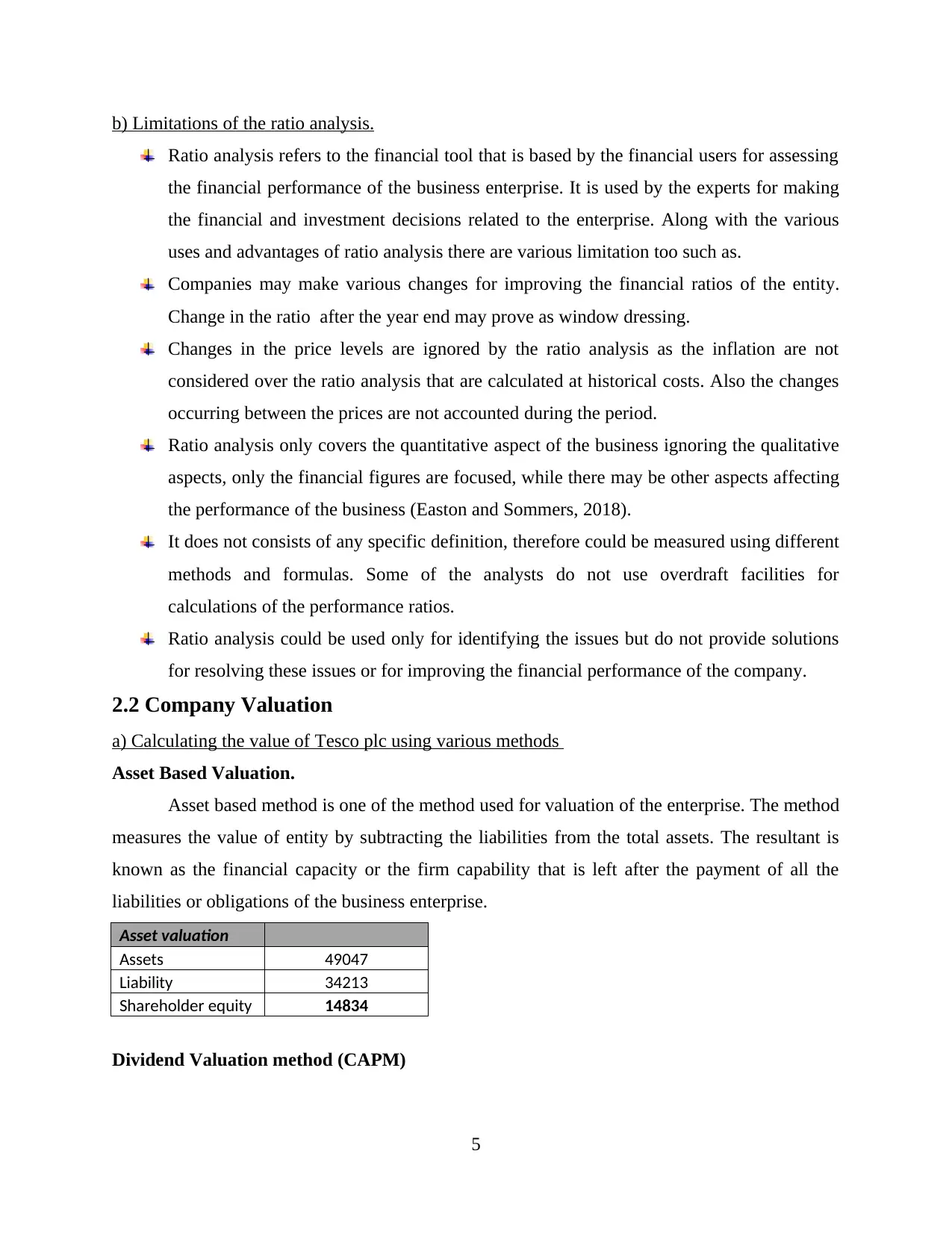
b) Limitations of the ratio analysis.
Ratio analysis refers to the financial tool that is based by the financial users for assessing
the financial performance of the business enterprise. It is used by the experts for making
the financial and investment decisions related to the enterprise. Along with the various
uses and advantages of ratio analysis there are various limitation too such as.
Companies may make various changes for improving the financial ratios of the entity.
Change in the ratio after the year end may prove as window dressing.
Changes in the price levels are ignored by the ratio analysis as the inflation are not
considered over the ratio analysis that are calculated at historical costs. Also the changes
occurring between the prices are not accounted during the period.
Ratio analysis only covers the quantitative aspect of the business ignoring the qualitative
aspects, only the financial figures are focused, while there may be other aspects affecting
the performance of the business (Easton and Sommers, 2018).
It does not consists of any specific definition, therefore could be measured using different
methods and formulas. Some of the analysts do not use overdraft facilities for
calculations of the performance ratios.
Ratio analysis could be used only for identifying the issues but do not provide solutions
for resolving these issues or for improving the financial performance of the company.
2.2 Company Valuation
a) Calculating the value of Tesco plc using various methods
Asset Based Valuation.
Asset based method is one of the method used for valuation of the enterprise. The method
measures the value of entity by subtracting the liabilities from the total assets. The resultant is
known as the financial capacity or the firm capability that is left after the payment of all the
liabilities or obligations of the business enterprise.
Asset valuation
Assets 49047
Liability 34213
Shareholder equity 14834
Dividend Valuation method (CAPM)
5
Ratio analysis refers to the financial tool that is based by the financial users for assessing
the financial performance of the business enterprise. It is used by the experts for making
the financial and investment decisions related to the enterprise. Along with the various
uses and advantages of ratio analysis there are various limitation too such as.
Companies may make various changes for improving the financial ratios of the entity.
Change in the ratio after the year end may prove as window dressing.
Changes in the price levels are ignored by the ratio analysis as the inflation are not
considered over the ratio analysis that are calculated at historical costs. Also the changes
occurring between the prices are not accounted during the period.
Ratio analysis only covers the quantitative aspect of the business ignoring the qualitative
aspects, only the financial figures are focused, while there may be other aspects affecting
the performance of the business (Easton and Sommers, 2018).
It does not consists of any specific definition, therefore could be measured using different
methods and formulas. Some of the analysts do not use overdraft facilities for
calculations of the performance ratios.
Ratio analysis could be used only for identifying the issues but do not provide solutions
for resolving these issues or for improving the financial performance of the company.
2.2 Company Valuation
a) Calculating the value of Tesco plc using various methods
Asset Based Valuation.
Asset based method is one of the method used for valuation of the enterprise. The method
measures the value of entity by subtracting the liabilities from the total assets. The resultant is
known as the financial capacity or the firm capability that is left after the payment of all the
liabilities or obligations of the business enterprise.
Asset valuation
Assets 49047
Liability 34213
Shareholder equity 14834
Dividend Valuation method (CAPM)
5
Paraphrase This Document
Need a fresh take? Get an instant paraphrase of this document with our AI Paraphraser
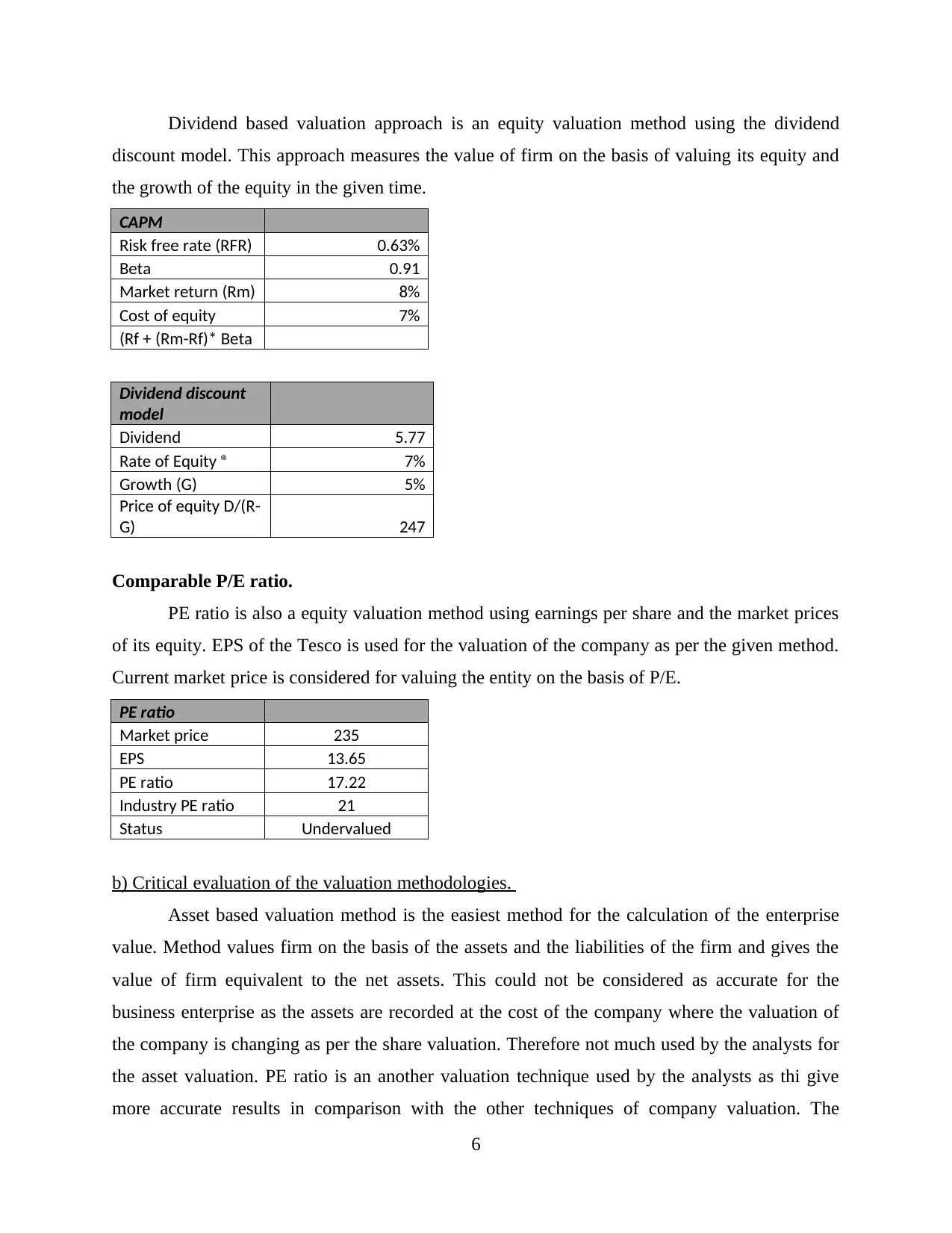
Dividend based valuation approach is an equity valuation method using the dividend
discount model. This approach measures the value of firm on the basis of valuing its equity and
the growth of the equity in the given time.
CAPM
Risk free rate (RFR) 0.63%
Beta 0.91
Market return (Rm) 8%
Cost of equity 7%
(Rf + (Rm-Rf)* Beta
Dividend discount
model
Dividend 5.77
Rate of Equity ® 7%
Growth (G) 5%
Price of equity D/(R-
G) 247
Comparable P/E ratio.
PE ratio is also a equity valuation method using earnings per share and the market prices
of its equity. EPS of the Tesco is used for the valuation of the company as per the given method.
Current market price is considered for valuing the entity on the basis of P/E.
PE ratio
Market price 235
EPS 13.65
PE ratio 17.22
Industry PE ratio 21
Status Undervalued
b) Critical evaluation of the valuation methodologies.
Asset based valuation method is the easiest method for the calculation of the enterprise
value. Method values firm on the basis of the assets and the liabilities of the firm and gives the
value of firm equivalent to the net assets. This could not be considered as accurate for the
business enterprise as the assets are recorded at the cost of the company where the valuation of
the company is changing as per the share valuation. Therefore not much used by the analysts for
the asset valuation. PE ratio is an another valuation technique used by the analysts as thi give
more accurate results in comparison with the other techniques of company valuation. The
6
discount model. This approach measures the value of firm on the basis of valuing its equity and
the growth of the equity in the given time.
CAPM
Risk free rate (RFR) 0.63%
Beta 0.91
Market return (Rm) 8%
Cost of equity 7%
(Rf + (Rm-Rf)* Beta
Dividend discount
model
Dividend 5.77
Rate of Equity ® 7%
Growth (G) 5%
Price of equity D/(R-
G) 247
Comparable P/E ratio.
PE ratio is also a equity valuation method using earnings per share and the market prices
of its equity. EPS of the Tesco is used for the valuation of the company as per the given method.
Current market price is considered for valuing the entity on the basis of P/E.
PE ratio
Market price 235
EPS 13.65
PE ratio 17.22
Industry PE ratio 21
Status Undervalued
b) Critical evaluation of the valuation methodologies.
Asset based valuation method is the easiest method for the calculation of the enterprise
value. Method values firm on the basis of the assets and the liabilities of the firm and gives the
value of firm equivalent to the net assets. This could not be considered as accurate for the
business enterprise as the assets are recorded at the cost of the company where the valuation of
the company is changing as per the share valuation. Therefore not much used by the analysts for
the asset valuation. PE ratio is an another valuation technique used by the analysts as thi give
more accurate results in comparison with the other techniques of company valuation. The
6
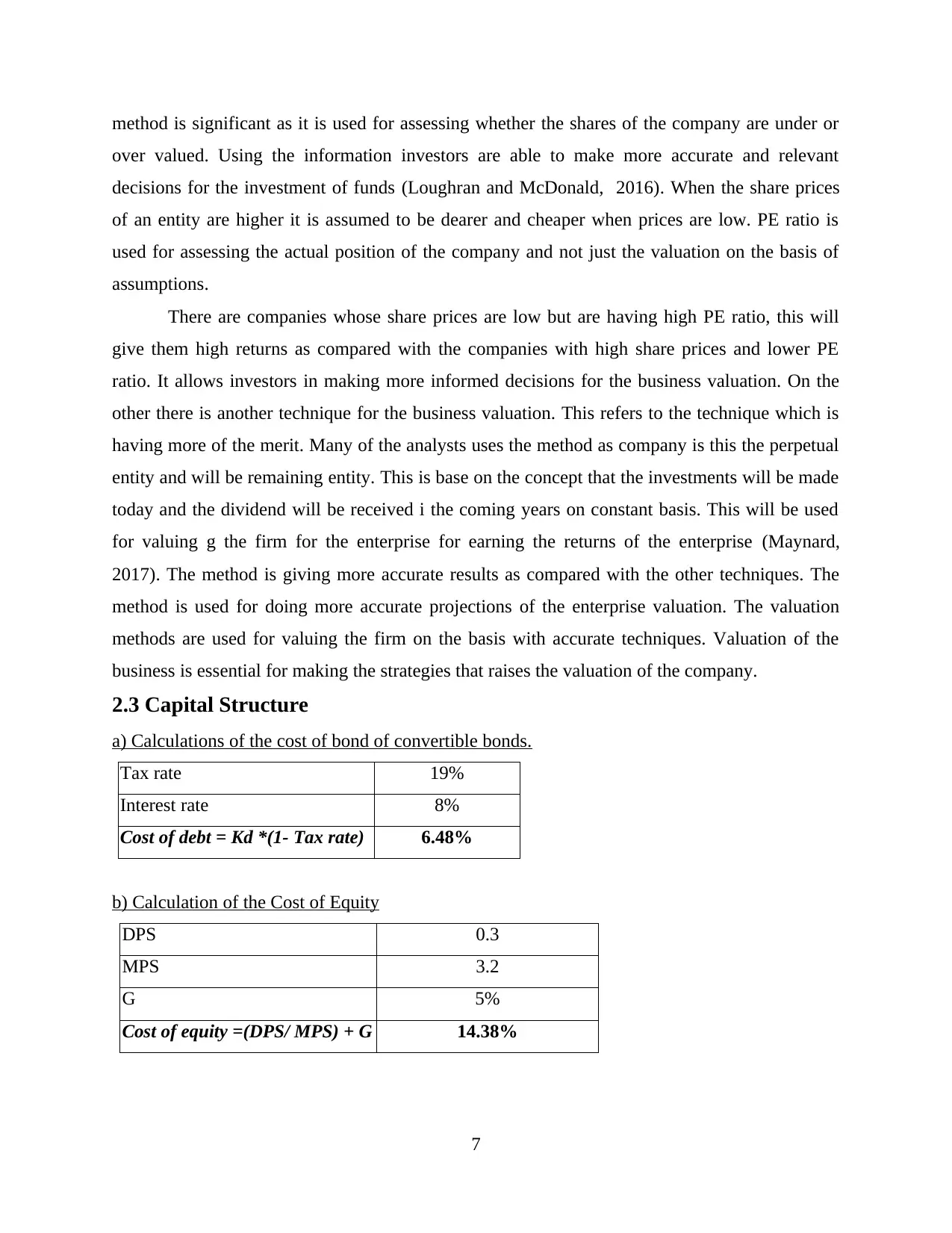
method is significant as it is used for assessing whether the shares of the company are under or
over valued. Using the information investors are able to make more accurate and relevant
decisions for the investment of funds (Loughran and McDonald, 2016). When the share prices
of an entity are higher it is assumed to be dearer and cheaper when prices are low. PE ratio is
used for assessing the actual position of the company and not just the valuation on the basis of
assumptions.
There are companies whose share prices are low but are having high PE ratio, this will
give them high returns as compared with the companies with high share prices and lower PE
ratio. It allows investors in making more informed decisions for the business valuation. On the
other there is another technique for the business valuation. This refers to the technique which is
having more of the merit. Many of the analysts uses the method as company is this the perpetual
entity and will be remaining entity. This is base on the concept that the investments will be made
today and the dividend will be received i the coming years on constant basis. This will be used
for valuing g the firm for the enterprise for earning the returns of the enterprise (Maynard,
2017). The method is giving more accurate results as compared with the other techniques. The
method is used for doing more accurate projections of the enterprise valuation. The valuation
methods are used for valuing the firm on the basis with accurate techniques. Valuation of the
business is essential for making the strategies that raises the valuation of the company.
2.3 Capital Structure
a) Calculations of the cost of bond of convertible bonds.
Tax rate 19%
Interest rate 8%
Cost of debt = Kd *(1- Tax rate) 6.48%
b) Calculation of the Cost of Equity
DPS 0.3
MPS 3.2
G 5%
Cost of equity =(DPS/ MPS) + G 14.38%
7
over valued. Using the information investors are able to make more accurate and relevant
decisions for the investment of funds (Loughran and McDonald, 2016). When the share prices
of an entity are higher it is assumed to be dearer and cheaper when prices are low. PE ratio is
used for assessing the actual position of the company and not just the valuation on the basis of
assumptions.
There are companies whose share prices are low but are having high PE ratio, this will
give them high returns as compared with the companies with high share prices and lower PE
ratio. It allows investors in making more informed decisions for the business valuation. On the
other there is another technique for the business valuation. This refers to the technique which is
having more of the merit. Many of the analysts uses the method as company is this the perpetual
entity and will be remaining entity. This is base on the concept that the investments will be made
today and the dividend will be received i the coming years on constant basis. This will be used
for valuing g the firm for the enterprise for earning the returns of the enterprise (Maynard,
2017). The method is giving more accurate results as compared with the other techniques. The
method is used for doing more accurate projections of the enterprise valuation. The valuation
methods are used for valuing the firm on the basis with accurate techniques. Valuation of the
business is essential for making the strategies that raises the valuation of the company.
2.3 Capital Structure
a) Calculations of the cost of bond of convertible bonds.
Tax rate 19%
Interest rate 8%
Cost of debt = Kd *(1- Tax rate) 6.48%
b) Calculation of the Cost of Equity
DPS 0.3
MPS 3.2
G 5%
Cost of equity =(DPS/ MPS) + G 14.38%
7
⊘ This is a preview!⊘
Do you want full access?
Subscribe today to unlock all pages.

Trusted by 1+ million students worldwide
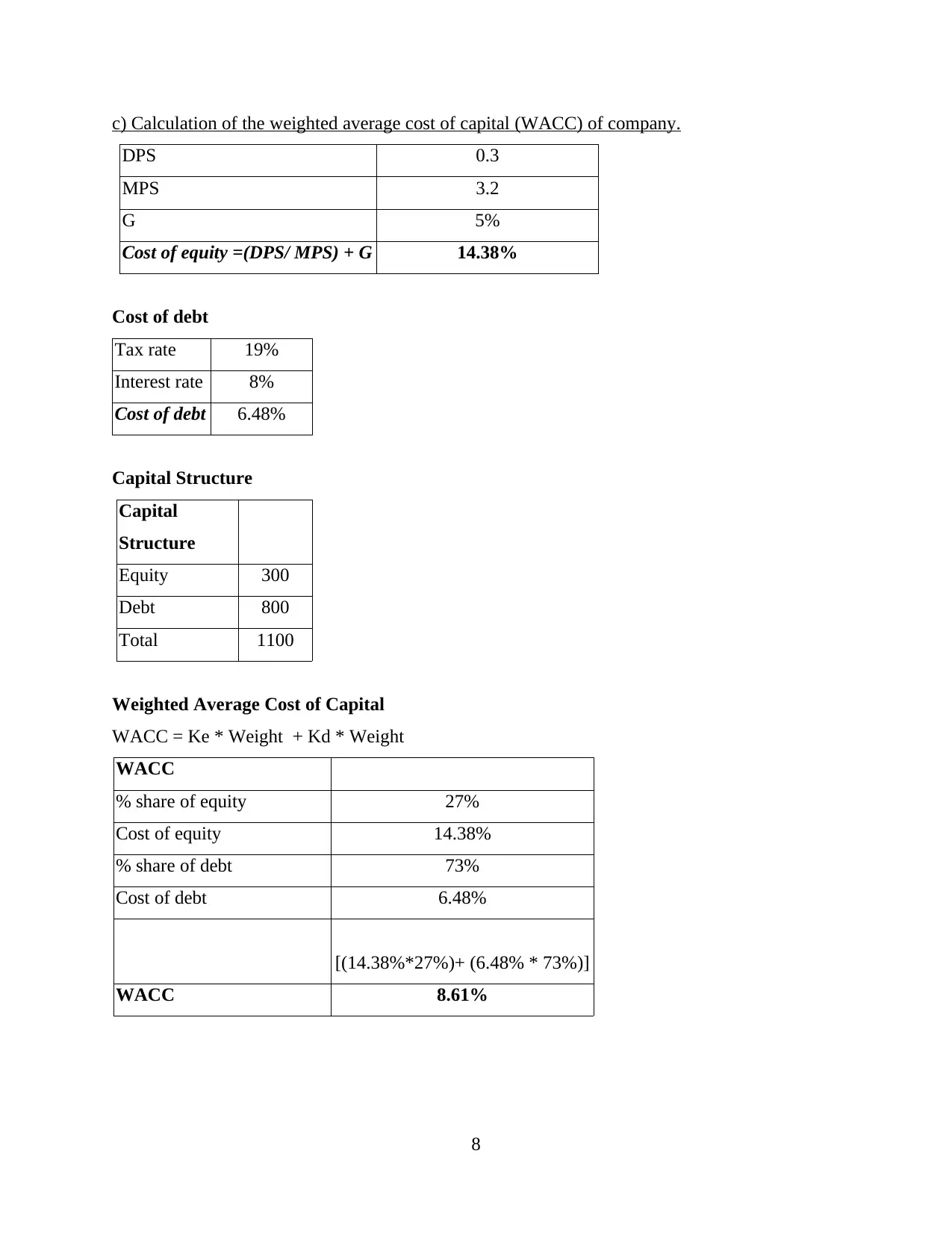
c) Calculation of the weighted average cost of capital (WACC) of company.
DPS 0.3
MPS 3.2
G 5%
Cost of equity =(DPS/ MPS) + G 14.38%
Cost of debt
Tax rate 19%
Interest rate 8%
Cost of debt 6.48%
Capital Structure
Capital
Structure
Equity 300
Debt 800
Total 1100
Weighted Average Cost of Capital
WACC = Ke * Weight + Kd * Weight
WACC
% share of equity 27%
Cost of equity 14.38%
% share of debt 73%
Cost of debt 6.48%
[(14.38%*27%)+ (6.48% * 73%)]
WACC 8.61%
8
DPS 0.3
MPS 3.2
G 5%
Cost of equity =(DPS/ MPS) + G 14.38%
Cost of debt
Tax rate 19%
Interest rate 8%
Cost of debt 6.48%
Capital Structure
Capital
Structure
Equity 300
Debt 800
Total 1100
Weighted Average Cost of Capital
WACC = Ke * Weight + Kd * Weight
WACC
% share of equity 27%
Cost of equity 14.38%
% share of debt 73%
Cost of debt 6.48%
[(14.38%*27%)+ (6.48% * 73%)]
WACC 8.61%
8
Paraphrase This Document
Need a fresh take? Get an instant paraphrase of this document with our AI Paraphraser

From the above measurement it could be interpreted that the WACC of the company is
8.61%. this shows that the cost of capital of the company has been properly managed by the
company. Increasing the cost above this will affect the business.
d) Evaluation of the difficulties faced by the enterprise in the calculation of WACC.
The calculation of WACC is straightforward in theory as compared to theory, because of
the following reason.
There are different methods used while estimating the cost of equity, such that Dividend
discount model and CAPM model. At that time, user aces problem especially related to one of
the variable is an estimate and it is not so easy. WACC model is a forward looking measure and
the entire calculations are based on the expected returns, not in the historical returns. Therefore,
for the equity also, the market value is consider rather than book value.
However, it is critically analyzed that while calculating WACC, there are different term
used such that risk- free bonds that is further used to determine the cost of debts and it is not
always actually matched the terms of the company's debt and as a result, it is consider difficult to
use practically (Siano and Wysocki, 2019). Further, if the company's structure is complex then it
gets more difficult to calculate. WACC because it requires a long calculation and in turn it
consumes lot of time. That is why, using this WACC is consider one of the most simplest
method for theory rather to use practically.
CONCLUSION
From the above study it could be concluded that the financial analysis is very important for
the business enterprise. Ratio analysis is used by the experts for analysing the performance of
business. capital structure of the company should be adequate for keeping the cost of capital of
company to minimum.
9
8.61%. this shows that the cost of capital of the company has been properly managed by the
company. Increasing the cost above this will affect the business.
d) Evaluation of the difficulties faced by the enterprise in the calculation of WACC.
The calculation of WACC is straightforward in theory as compared to theory, because of
the following reason.
There are different methods used while estimating the cost of equity, such that Dividend
discount model and CAPM model. At that time, user aces problem especially related to one of
the variable is an estimate and it is not so easy. WACC model is a forward looking measure and
the entire calculations are based on the expected returns, not in the historical returns. Therefore,
for the equity also, the market value is consider rather than book value.
However, it is critically analyzed that while calculating WACC, there are different term
used such that risk- free bonds that is further used to determine the cost of debts and it is not
always actually matched the terms of the company's debt and as a result, it is consider difficult to
use practically (Siano and Wysocki, 2019). Further, if the company's structure is complex then it
gets more difficult to calculate. WACC because it requires a long calculation and in turn it
consumes lot of time. That is why, using this WACC is consider one of the most simplest
method for theory rather to use practically.
CONCLUSION
From the above study it could be concluded that the financial analysis is very important for
the business enterprise. Ratio analysis is used by the experts for analysing the performance of
business. capital structure of the company should be adequate for keeping the cost of capital of
company to minimum.
9

REFERENCES
Books and Journals
Petrova, P., 2019. Accounting Analysis.
Schroeder, R.G., Clark, M.W. and Cathey, J.M., 2019. Financial accounting theory and
analysis: text and cases. John Wiley & Sons.
Loughran, T. and McDonald, B., 2016. Textual analysis in accounting and finance: A
survey. Journal of Accounting Research.54(4). pp.1187-1230.
Easton, M. and Sommers, Z., 2018. Financial Statement Analysis & Valuation, 5e.
Maynard, J., 2017. Financial accounting, reporting, and analysis. Oxford University Press.
Siano, F. and Wysocki, P., 2019. Transfer Learning and Textual Analysis of Accounting
Disclosures: Applying Big Data Methods to Small (er) Data Sets.
Li, W.S., 2018. Competitor Analysis and Accounting Model: Accounting Model. In Strategic
Management Accounting (pp. 125-141). Springer, Singapore.
Online
Tesco Plc. 2019. [Online]. Available through :
<https://www.londonstockexchange.com/exchange/prices/stocks/summary/fundamentals.html?
fourWayKey=GB0008847096GBGBXSET1>.
10
Books and Journals
Petrova, P., 2019. Accounting Analysis.
Schroeder, R.G., Clark, M.W. and Cathey, J.M., 2019. Financial accounting theory and
analysis: text and cases. John Wiley & Sons.
Loughran, T. and McDonald, B., 2016. Textual analysis in accounting and finance: A
survey. Journal of Accounting Research.54(4). pp.1187-1230.
Easton, M. and Sommers, Z., 2018. Financial Statement Analysis & Valuation, 5e.
Maynard, J., 2017. Financial accounting, reporting, and analysis. Oxford University Press.
Siano, F. and Wysocki, P., 2019. Transfer Learning and Textual Analysis of Accounting
Disclosures: Applying Big Data Methods to Small (er) Data Sets.
Li, W.S., 2018. Competitor Analysis and Accounting Model: Accounting Model. In Strategic
Management Accounting (pp. 125-141). Springer, Singapore.
Online
Tesco Plc. 2019. [Online]. Available through :
<https://www.londonstockexchange.com/exchange/prices/stocks/summary/fundamentals.html?
fourWayKey=GB0008847096GBGBXSET1>.
10
⊘ This is a preview!⊘
Do you want full access?
Subscribe today to unlock all pages.

Trusted by 1+ million students worldwide
1 out of 12
Related Documents
Your All-in-One AI-Powered Toolkit for Academic Success.
+13062052269
info@desklib.com
Available 24*7 on WhatsApp / Email
![[object Object]](/_next/static/media/star-bottom.7253800d.svg)
Unlock your academic potential
Copyright © 2020–2025 A2Z Services. All Rights Reserved. Developed and managed by ZUCOL.





